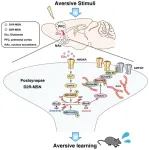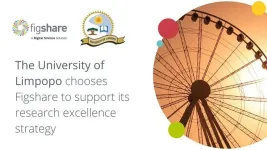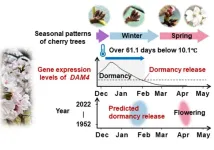(Press-News.org) CLEVELAND—With a new four-year, $1.14 million grant from the U.S. Department of Veterans Affairs, researchers at Case Western Reserve University and the Louis Stokes Cleveland VA Medical Center, will use artificial intelligence (AI) to determine the best personalized treatment for Veterans with rectal cancer.
Colorectal cancers are the third-most common type of cancer in military personnel, affecting up to 8% of Veterans and 5% of active-duty Service members, according to the American Cancer Society (ACS). More than 152,000 patients in the United States will be diagnosed with colorectal cancer in 2024, with more than 46,000 localized to the rectum, according to the ACS.
Satish Viswanath, co-director of the Center for AI Enabling Discovery in Disease Biology (AID2B) at Case Western Reserve and a biomedical engineer and research scientist at the Cleveland VA Medical Center, along with VA co-investigators, plan to use AI to develop an algorithm that analyzes magnetic resonance imaging (MRI) scans to better understand how rectal tumors respond to treatment.
The AI tool, called the computational image Rectal Response Classifier (ciRRC), will assess MRI data in more detail than human evaluation alone. The hope is the tool, once fully developed and tested, will allow doctors to offer Veterans timely customized precision oncology treatment.
“Rectal cancer patients undergo a one-size-fits-all treatment protocol that almost always requires surgery, but surgery comes with inherent risks and complications, including patients having a worse quality of life,” said Eric Marderstein, co-investigator and section chief of general and colorectal surgery at the Cleveland VA Medical Center. “We urgently need better markers to assess the risk of metastasis and invasion so patients can be recommended additional therapy to maximize their chance of survival.”
With the advent of newer combinations of treatments, like chemotherapy and radiation therapy, doctors could use ciRRC to determine whether a patient may be resistant to a specific treatment regimen. They could then offer different options to help patients avoid complications and decide the level of treatment.
The study also includes a unique multi-institutional validation of ciRRC across Midwest VA Medical Centers to expand its potential impact.
“Time is of the essence, especially for Veterans who tend to be older than other rectal cancer patients,” Viswanath said. “Our project addresses this critical need to improve outcomes and quality of life for Veterans.”
###
Case Western Reserve University is one of the country's leading private research institutions. Located in Cleveland, we offer a unique combination of forward-thinking educational opportunities in an inspiring cultural setting. Our leading-edge faculty engage in teaching and research in a collaborative, hands-on environment. Our nationally recognized programs include arts and sciences, dental medicine, engineering, law, management, medicine, nursing and social work. About 6,000 undergraduate and 6,300 graduate students comprise our student body. Visit case.edu to see how Case Western Reserve thinks beyond the possible.
ABOUT VA NORTHEAST OHIO HEALTHCARE SYSTEM: Focusing on treating the whole Veteran through health promotion and disease prevention, VA Northeast Ohio Healthcare System provides comprehensive, seamless health care and social services for more than 135,000 Veterans across Northeast Ohio. With 17 locations of care, including 12 outpatient clinics, two community resource and referral centers, a psychosocial rehabilitation and recovery center, a chronic dialysis center, and an outpatient surgery center, VA Northeast Ohio Healthcare System’s quality services are easily accessible to Veterans in 21 counties. VA Northeast Ohio Healthcare System also contributes to the future of medicine through education, training, and research programs. For more information about programs and services offered by VA Northeast Ohio Healthcare System, visit www.cleveland.va.gov or follow us on Facebook, Instagram or X @ClevelandVAMC.
END
COLUMBUS, Ohio – For the first time, scientists are able to directly compare the different kinds of injury that mechanical ventilation causes to cells in the lungs.
In a new study, using a ventilator-on-a-chip model developed at The Ohio State University, researchers found that shear stress from the collapse and reopening of the air sacs is the most injurious type of damage.
This miniature “organ-on-a-chip” model simulates not only lung injury during mechanical ventilation, but also repair and recovery, in human-derived cells in real time, said co-lead author ...
Enrollment of low-income, undocumented students declined by half at University of California and California State University campuses from 2016 through the 2022-23 academic year, according to a new study by the University of California Civil Rights Project at UCLA and UC Davis School of Law.
The paper, “‘California Dreamin’: DACA’s Decline and Undocumented College Student Enrollment in the Golden State” is believed to be the first to report on data collected during an era marked by increasing limitations on DACA, or Deferred Action for Childhood Arrivals.
Further, researchers found, for UC and CSU low-income undocumented ...
One of the things that makes brains so incredibly difficult to understand is their ability to adjust and adapt. Our learning experiences can set off complex signaling cascades that reshape neurons—and their synaptic connections—at the cellular level. For example, in mammals, scientists have established that activation of the N-methyl-D-aspartate receptor (NMDAR) and the ensuing calcium ion (Ca2+)-dependent signaling cascade is essential for postsynaptic remodeling and learning. As one might reasonably expect, ...
Samarium (Sm), a rare earth metal, is important to organic chemists because of the ability of its divalent compounds to efficiently perform single-electron transfer reductions. Samarium iodide (SmI2) is moderately stable and can operate under mild conditions at room temperature, making it highly useful for producing pharmaceuticals and biologically active materials. However, most reactions require SmI2 in quantities equal to or greater than the stoichiometric amount and necessitate the use of harmful chemicals, making the process resource-intensive and expensive to manage.
Several approaches have been studied to reduce ...
Scientists have learned how plants keep viruses from being passed to their offspring, a finding that could ensure healthier crops. The discovery could also help reduce the transmission of diseases from mothers to human children.
Plant viruses are often able to spread from one country to another through the seed trade. As a result, parent-to-progeny disease transmission is of global concern.
“Viruses can hide in seeds for years, making this one of the most important issues in agriculture,” said UC Riverside distinguished professor Shou-Wei Ding in the Department of Microbiology and Plant Pathology. Ding is corresponding author of a new paper about the ...
HOUSTON – (Sept. 19, 2024) – Rice University and Baylor College of Medicine have received $2.8 million in funding from the National Heart, Lung, and Blood Institute (NHLBI), a division of the National Institutes of Health (NIH), for research on reducing inflammation and lung damage in acute respiratory distress syndrome (ARDS) patients.
The study, titled “Cell Based Immunomodulation to Suppress Lung Inflammation and Promote Repair,” will be co-led by Omid Veiseh, a professor of bioengineering and faculty director of the Rice Biotech Launch Pad, and Ravi Kiran Ghanta, a professor of surgery at Baylor. ...
Figshare, a leading provider of institutional repository infrastructure that supports open research, is pleased to announce that the University of Limpopo has chosen Figshare to facilitate the collection, management, sharing and preservation of its research data.
The University of Limpopo – one of the top public universities in South Africa offering undergraduate and postgraduate qualifications, and a variety of short learning programmes – will become the 20th institution in the country using Figshare as their data repository.
Using ...
Fukuoka, Japan – Japan in spring is famous for its cherry blossoms, or sakura, which begin flowering in the southern region of Kyushu and blaze upwards to the remote north of Hokkaido. The most abundant cherry tree cultivar, Somei Yoshino, is the iconic symbol of spring, as the cloned trees flower simultaneously at each site, creating a fleeting explosion of white-pink blossom that enraptures locals and tourists alike. The flowering forecasts of Somei Yoshino are poured over for months before flowering, as visitors plan their trips and locals ...
Fukuoka, Japan—Researchers have developed a new organic thermoelectric device that can harvest energy from ambient temperature. While thermoelectric devices have several uses today, hurdles still exist to their full utilization. By combining the unique abilities of organic materials, the team succeeded in developing a framework for thermoelectric power generation at room temperature without any temperature gradient. Their findings were published in the journal Nature Communications.
Thermoelectric devices, or thermoelectric ...
The superior colliculus is a midbrain region that is traditionally thought to help animals orient themselves toward important locations in space, like directing their eyes and head toward a bright flash of light. New research from the University of Chicago shows that this part of the brain also plays a role in complex cognitive tasks like visual categorization and decision making.
In the new study, published in Nature Neuroscience, scientists measured the information contained in patterns of brain cell activity across multiple brain regions involved in visual category decisions. The researchers monitored activity in the superior colliculus (SC) and part of the posterior parietal ...







